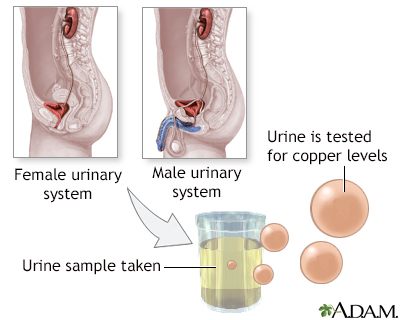Pregnancy SmartSiteTM
Quantitative urinary copper DefinitionThe 24-hour urine copper test measures the amount of copper in a urine sample. How the Test is PerformedA 24-hour urine sample is needed.
Label the container with your name, the date, the time of completion, and return it as instructed. For an infant, thoroughly wash the area where urine exits the body.
This procedure may take more than one try. An active infant can move the bag, so that the urine leaks into the diaper. Check the infant often and change the bag after the infant has urinated into it. Drain the urine from the bag into the container given to you by your health care provider. Return the bag or container as instructed. A laboratory specialist will determine how much copper is in the sample. How to Prepare for the TestNo special preparation is necessary for this test. Extra collection bags may be needed if the sample is being taken from an infant. How the Test will FeelThe test involves only normal urination, and there is no discomfort. Why the Test is PerformedYour provider may order this test if you have signs of Wilson disease, a genetic disorder that affects how the body processes copper. Normal ResultsThe normal range is 10 to 30 micrograms per 24 hours. Note: Normal value ranges may vary slightly among different laboratories. Talk to your provider about the meaning of your specific test results. The examples above show the common measurements for results for these tests. Some laboratories use different measurements or may test different specimens. What Abnormal Results MeanAn abnormal result means you have a higher than normal level of copper. This may be due to:
RisksThere are no risks associated with providing a urine sample. ReferencesRiley RS, McPherson RA. Basic examination of urine. In: McPherson RA, Pincus MR, eds. Henry's Clinical Diagnosis and Management by Laboratory Methods. 24th ed. Philadelphia, PA: Elsevier; 2022:chap 29. Schilsky ML. Wilson disease and related disorders. In: Friedman LS, Martin P, eds. Handbook of Liver Disease. 4th ed. Philadelphia, PA: Elsevier; 2018:chap 19. Williams MJ, Gordon-Walker TT. Hepatology. In: Penman ID, Ralston SH, Strachan MWJ, Hobson RP, eds. Davidson's Principles and Practice of Medicine. 24th ed. Philadelphia, PA: Elsevier; 2023:chap 24. | |
| |
Review Date: 1/24/2023 Reviewed By: Neil K. Kaneshiro, MD, MHA, Clinical Professor of Pediatrics, University of Washington School of Medicine, Seattle, WA. Also reviewed by David C. Dugdale, MD, Medical Director, Brenda Conaway, Editorial Director, and the A.D.A.M. Editorial team. The information provided herein should not be used during any medical emergency or for the diagnosis or treatment of any medical condition. A licensed medical professional should be consulted for diagnosis and treatment of any and all medical conditions. Links to other sites are provided for information only -- they do not constitute endorsements of those other sites. No warranty of any kind, either expressed or implied, is made as to the accuracy, reliability, timeliness, or correctness of any translations made by a third-party service of the information provided herein into any other language. © 1997- A.D.A.M., a business unit of Ebix, Inc. Any duplication or distribution of the information contained herein is strictly prohibited. | |

 Copper urine test
Copper urine test
